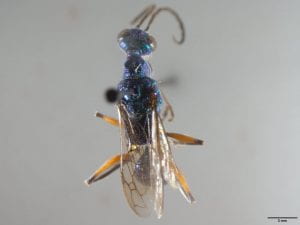
This week’s wasp is the cockroach hunter wasp species Ampulex compressa, the emerald cockroach wasp! This species was first described by Johan Christian Fabricius in the year 1781, who originally placed it in the genus Sphex. The specimen photographed here was collected in Hawaii by W. W. Boyle, a previous manager of the Frost Entomological Museum. This species is native to the tropical regions of Africa, Asia, and the Pacific Islands. It was also introduced to Hawaii in 1941 as a means of biological control against cockroaches, although the effort has overall been deemed unsuccessful.
Taxonomy: This species is a member of the superfamily Apoidea and the family Ampulicidae. The superfamily Apoidea includes bees and the few groups of wasps to which bees are closely related. The family Ampulicidae contains around 170 living species, which are classified in two subfamilies and six genera. The genus Ampulex is the most speciose genus of the family, and is found worldwide.

Identification: The family Ampulicidae can be distinguished from the other families of apoid wasps by the combination of several key features:
- Tarsal claws always toothed along the inner margin (In other groups, they are sometimes toothed but are often entirely simple and untoothed)
- Two spurs at the apex of the tibia of the middle leg (Other apoid wasps may have one, two, or even none)
- Jugal lobe of the hind wing small or entirely absent (Present or absent in other apoid wasps, but usually quite large when it is present)
- Petiolate segment of the metasoma is composed of both a tergum and a sternum (separates Ampulicidae from the similar-looking family Sphecidae)
This species in particular is recognized amongst ampulicid wasps by the metallic turquoise body and the red femora of the second and third pairs of legs. The combination of these features separate this species from those that are closely related.

Natural History: Ampulicid wasps are hunters of cockroaches, and provision their nests with live roaches for their larvae to feed on. This species is known to attack roaches of the genus Periplaneta among other groups. These wasps are particularly notable for their exceptional behaviors within hunting their prey. The wasp is often much smaller than the roaches it hunts, meaning they have to get creative within how they capture a roach host. An ampulicid wasp usually disables the escape reflexes of its prey before dragging it back to its nest, typically by injecting the nervous system with venom and then severing the antennae of the roach. After disabling and incapacitating the roach, the ampulicid “leads” it back to its burrow by dragging it by the head. Once in the nest with wasp’s eggs, the roach waits, paralyzed and unable to move, until the eggs hatch and the new ampulicid wasp larvae eat it from the inside out.
View This Species On:
iNaturalist: https://www.inaturalist.org/taxa/348362-Ampulex-compressa/
References:
- Aguiar, A. P., Deans, A. R., Engel, M. S., Forshage, M., Huber, J. T., Jennings, J. T., … & Miko, I. (2013). Order Hymenoptera. In: Zhang, Z.-Q.(Ed.) Animal Biodiversity: An Outline of Higher-level Classification and Survey of Taxonomic Richness (Addenda 2013). Zootaxa, 3703(1), 51-62.
- Goulet, H., Huber, J. T. (1993). Hymenoptera of the world: An identification guide to families. Ottawa: Research Branch Agriculture Canada.
- Kim, K. C. (1969) The Frost Entomological Museum, Bulletin of the Entomological Society of America, 15(2): 82.
- Williams, F. X. (1942). Ampulex compressa (Fabr.), a cockroach-hunting wasp introduced from New Caledonia into Hawaii. Proclamations of the Hawaiian Entomological Society. 11: 221–233.
Leave a Reply